Science & Environment
Oil jumps as market waits for Israel attack on Iran


U.S. crude oil rose nearly 3% on Monday, as the market waited for Israel to strike Iran.
Oil prices spiked last week on fears that Israel could hit the Iran’s oil industry in retaliation for Tehran’s ballistic missile attack.
U.S benchmark West Texas Intermediate surged 9.09% last week for the biggest weekly gain since March 2023. Global benchmark Brent jumped 8.43% for the biggest weekly advance since January 2023.
Here are Monday’s energy prices:
- West Texas Intermediate November contract: $76.44 per barrel, up $2.06, or 2.77%.
- Brent December contract: $79.91 per barrel, $1.86, or 2.38%.
President Joe Biden on Friday discouraged Israel from striking Iranian oil facilities, after prices jumped about 5% a day earlier when the president suggested the U.S. was discussing the possibility of such a strike.
Science & Environment
Nobel Prize goes to microRNA researchers

 Reuters
ReutersThe Nobel Prize in Physiology or Medicine 2024 has been awarded to US scientists Victor Ambros and Gary Ruvkun for their work on microRNA.
Their discoveries help explain how complex life emerged on Earth and how the human body is made up of a wide variety of different tissues.
MicroRNAs influence how genes – the instructions for life – are controlled inside organisms, including us.
The winners share a prize fund worth 11m Swedish kronor (£810,000).
Every cell in the human body contains the same raw genetic information, locked in our DNA.
However, despite starting with the identical genetic information, the cells of the human body are wildly different in form and function.
The electrical impulses of nerve cells are distinct from the rhythmic beating of heart cells. The metabolic powerhouse that is a liver cell is distinct to a kidney cell, which filters urea out of the blood. The light-sensing abilities of cells in the retina are different in skillset to white blood cells that produce antibodies to fight infection.
So much variety can arise from the same starting material because of gene expression.
The US scientists were the first to discover microRNAs and how they exerted control on how genes are expressed differently in different tissues.
The medicine and physiology prize winners are selected by the Nobel Assembly of Sweden’s Karolinska Institute.
They said: “Their groundbreaking discovery revealed a completely new principle of gene regulation that turned out to be essential for multicellular organisms, including humans.
“It is now known that the human genome codes for over 1,000 microRNAs.”
Allow Twitter content?
Without the ability to control gene expression, every cell in an organism would be identical, so microRNAs helped enable the evolution of complex life forms.
Abnormal regulation by microRNAs can contribute to cancer and to some conditions, including congenital hearing loss and bone disorders.
A severe example is DICER1 syndrome, which leads to cancer in a variety of tissues, and is caused by mutations that affect microRNAs.
 Getty Images
Getty ImagesProf Ambros, 70, works at the University of Massachusetts Medical School, and Prof Ruvkun, 72, is a professor at Harvard Medical School.
Both conducted their research on the nematode worm – C. elegans.
They experimented on a mutant form of the worm that failed to develop some cell types, and eventually homed in on tiny pieces of genetic material or microRNAs that were essential for the worms’ development.
This is how it works:
- A gene or genetic instruction is contained within our DNA
- Our cells make a copy, which is called messenger RNA or simply mRNA (you’ll remember this from Covid vaccines)
- This travels out of the cell’s nucleus and instructs the cell’s protein-making factories to start making a specific protein
- But microRNAs get in the way by sticking to the messenger RNA and stop it working
- In essence the mircoRNA has prevented the gene from being expressed in the cell
Further work showed this was not a process unique to worms, but was a core component of life on Earth.
Prof Janosch Heller, from Dublin City University, said he was “delighted” to hear the prize had gone to Profs Ambros and Ruvkun.
“Their pioneering work into gene regulation by microRNAs paved the way for groundbreaking research into novel therapies for devastating diseases such as epilepsy, but also opened our eyes to the wonderful machinery that is tightly controlling what is happening in our cells.”
Previous winners
Science & Environment
Fed rate cuts should favor preferred stocks, Virtus fund manager says
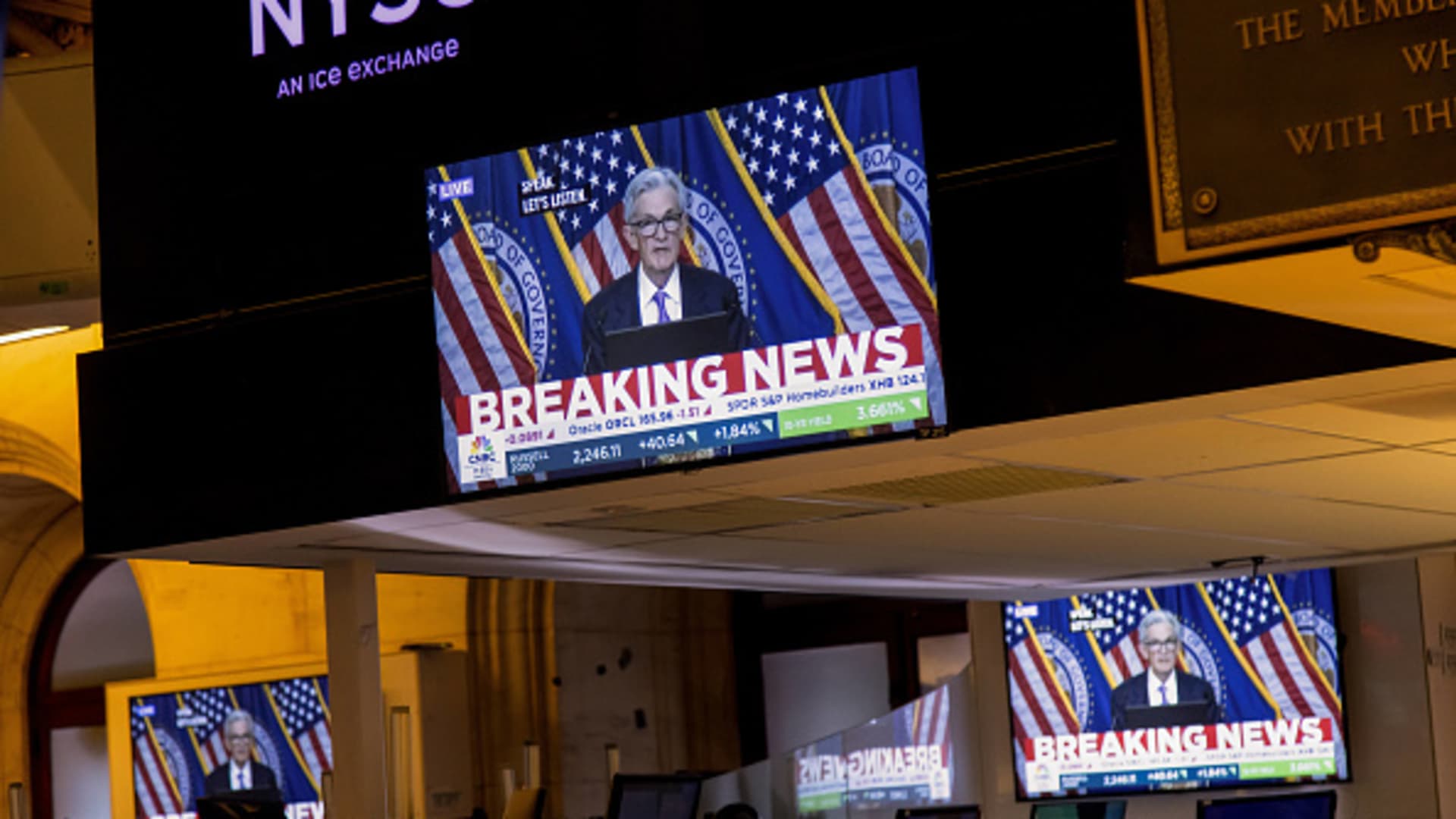

One financial firm is trying to capitalize on preferred stocks – which carry more risks than bonds, but aren’t as risky as common stocks.
Infrastructure Capital Advisors Founder and CEO Jay Hatfield manages the Virtus InfraCap U.S. Preferred Stock ETF (PFFA). He leads the company’s investing and business development.
“High yield bonds and preferred stocks… tend to do better than other fixed income categories when the stock market is strong, and when we’re coming out of a tightening cycle like we are now,” he told CNBC’s “ETF Edge” this week.
Hatfield’s ETF is up 10% in 2024 and almost 23% over the past year.
His ETF’s three top holdings are Regions Financial, SLM Corporation, and Energy Transfer LP as of Sept. 30, according to FactSet. All three stocks are up about 18% or more this year.
Hatfield’s team selects names that it deems are mispriced relative to their risk and yield, he said. “Most of the top holdings are in what we call asset intensive businesses,” Hatfield said.
Since its May 2018 inception, the Virtus InfraCap U.S. Preferred Stock ETF is down almost 9%.
Science & Environment
Maps of northern lights forecast show which U.S. states could see aurora borealis this weekend
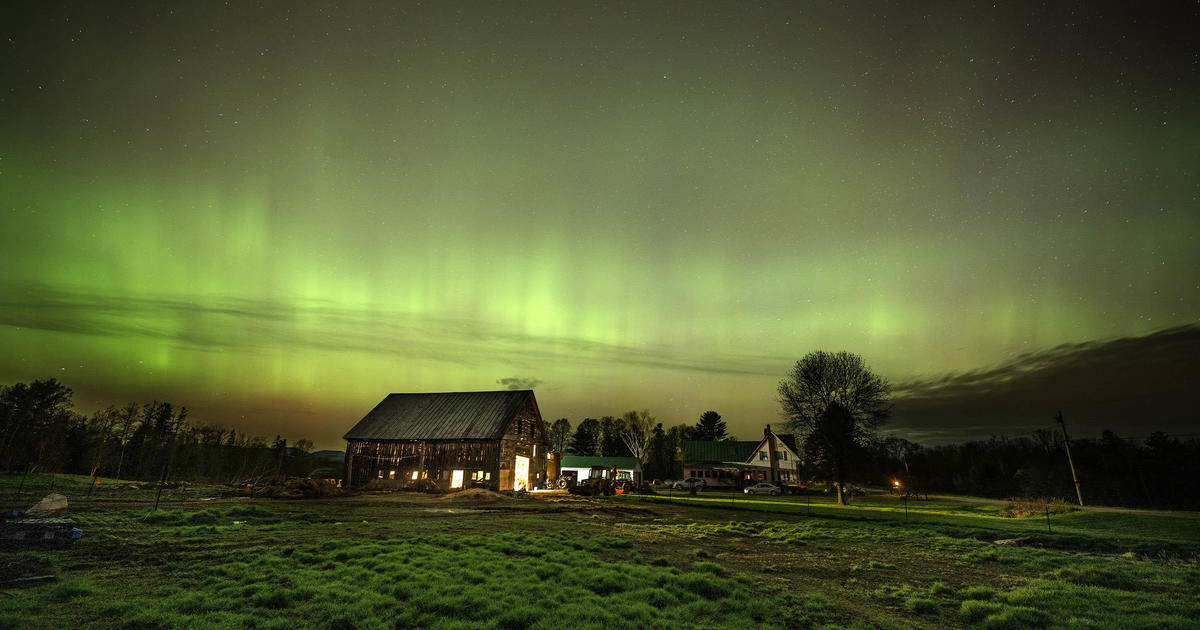
The northern lights could dazzle millions of Americans in some northern states this weekend. An eruption of solar material from the sun earlier this week could lead to a show of the aurora borealis if the weather conditions are right, officials said.
The eruption, called a coronal mass ejection, prompted the federal government’s Space Weather Prediction Center in Colorado to issue a geomagnetic storm watch for Friday, Saturday and Sunday to alert people about potential disruptions to navigation, power and radio systems.
What time will the northern lights be visible tonight?
The northern lights can be seen just after sunset and just before sunrise, but it’s best to go out at night and away from city lights, according to the center.
The center recommends viewing the northern lights between 10 p.m. and 2 a.m. local time. According to the center, the best times of the year to see the aurora borealis are around the spring and fall equinoxes. The fall equinox was on Sept. 22.
Where can you see the northern lights tonight?
The northern lights could be seen as far south as Iowa, Oregon and Pennsylvania, according to the center.
If the conditions are right and the northern lights are bright, they can be seen from as far as 620 miles away, according to the center.
Northern lights map for tonight
The center released a map showing the northern lights forecast for Friday night. The map illustrates the predicted intensity of the aurora borealis over North America with a line showing how far south the lights could be seen on the northern horizon.
Northern lights map for tomorrow night
The center also released a map for Saturday night.
Parts of the country were treated to the northern lights last spring when a powerful geomagnetic storm reached Earth. While the storm expected this weekend is considered to be strong, it’s not supposed to be as powerful as the one in May.
Science & Environment
Supreme Court declines to block Biden rules on planet-warming methane, toxic mercury
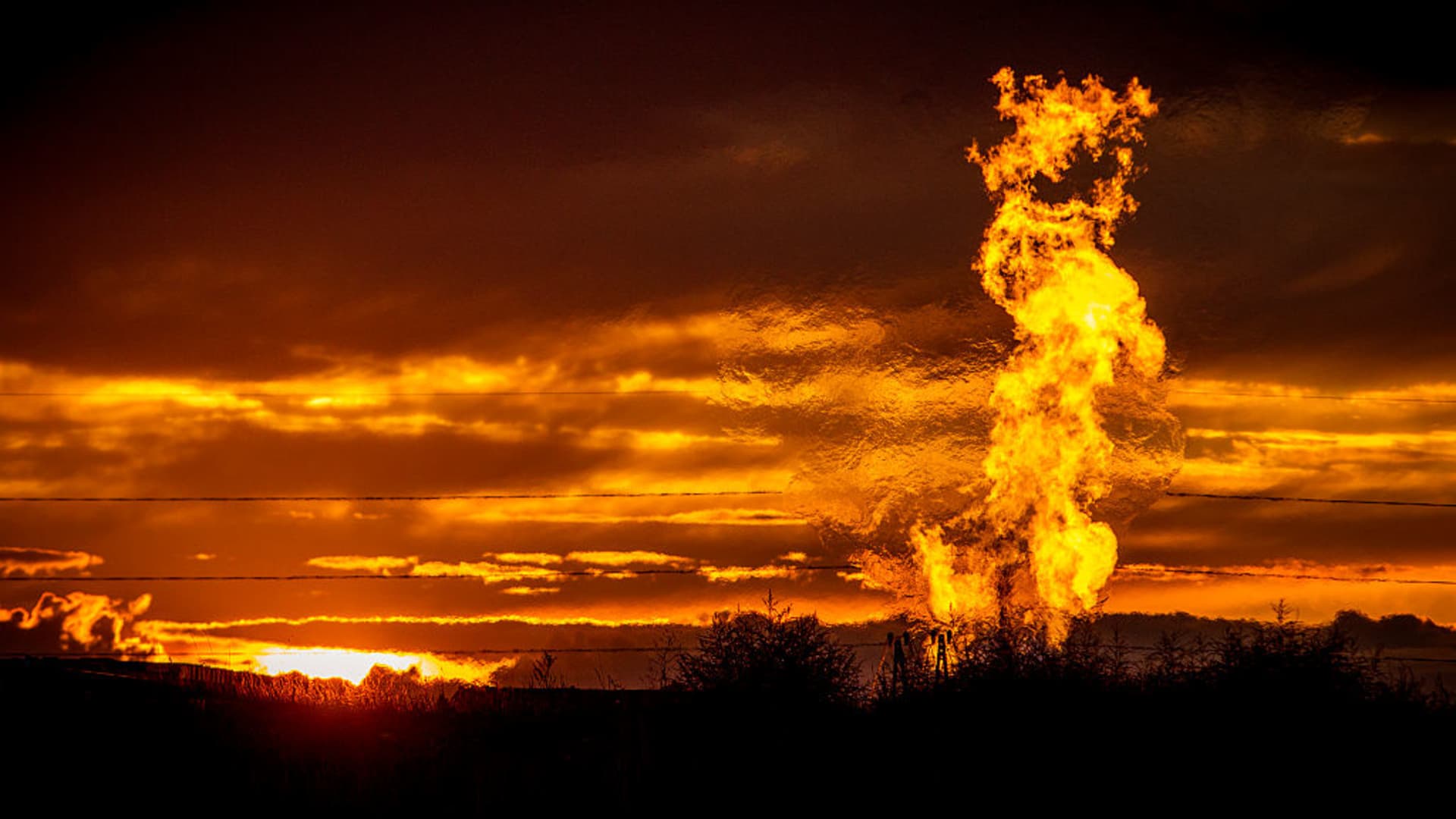
Flames from a flaring pit near a well in the Bakken Oil Field. The primary component of natural gas is methane, which is odorless when it comes directly out of the gas well. In addition to methane, natural gas typically contains other hydrocarbons such as ethane, propane, butane, and pentanes.
Orjan F. Ellingvag | Corbis News | Getty Images
The Supreme Court on Friday left in place Biden administration regulations aimed at curbing oil and gas facility emissions of methane, a major contributor to climate change.
In a separate action, the court also rejected a bid to block a separate regulation aimed at curbing emissions of mercury and other toxic pollutants from coal-fired power plants.
In both cases, the court rejected emergency applications without comment, with no noted dissents. Litigation will continue in lower courts.
A separate emergency application seeking to block Biden regulations concerning greenhouse gas emissions from coal- and gas-fired power plants remains pending.
The court’s decision in the methane case means that an Environmental Protection Agency regulation that was finalized in March and is intended to cut methane emissions by up to 80 percent over the next 14 years will remain in effect.
Methane is a greenhouse gas that is 80 times more potent than carbon dioxide at trapping heat once emitted into the atmosphere, hence contributing to global warming.
The regulation has been challenged by Republican states led by Oklahoma and various oil and gas industry groups.
The challengers portray the regulation in stark terms, with industry groups calling it an “authoritarian national command from the EPA” in their court filing. They say the regulation goes further than is allowed under the Clean Air Act, which gives states a role in implementing emissions reduction programs.
The states similarly argued in court papers that the administration is using provisions of the Clean Air Act that were never envisioned to address climate change to “shut down power plants in favor of other sources of generation.”
Solicitor General Elizabeth Prelogar, representing the Biden administration, dismissed those concerns, saying in her own filing that the agency has not trampled over the states in issuing its emissions guidelines.
“Like all EPA emission guidelines under that provision, those guidelines allow the states to decide what particular regulations to adopt,” she wrote. New presumptive standards issued by the EPA “simply give states a model that they may rely on if they choose,” she added.
The mercury regulation has less sweeping impacts, according to the EPA.
In that case, the court rejected an emergency request filed by conservative states and industry groups that want to block the EPA regulation issued this year.
Under the Clean Air Act provision in question, the EPA is required to curb hazardous pollutants while taking costs into account.
The regulation tightens existing regulations on mercury and other metals, such as arsenic and chromium.
In announcing the rule, the EPA said in April that the earlier 2012 regulation introduced by the Obama administration “has driven sharp reductions in harmful air toxic pollutants.” The new regulation would further limit emissions of mercury and other pollutants, providing health benefits of $300 million by reducing exposure to carcinogens, it said.
Science & Environment
WTI ahead nearly 9% on Mideast risk


U.S. crude oil is set to book a nearly 9% gain for the week, after President Joe Biden indicated that the White House is discussing a possible strike by Israel on Iran’s crude facilities in retaliation for Tehran’s ballistic missile strike earlier this week.
Oil prices would spike by $10 to $20 per barrel if an Israeli strike knocks out 1 million barrels per day of Iranian production over a sustained period, said Daan Struyven, head oil analyst at Goldman Sachs.
Just how high prices would go depends on whether OPEC uses its spare oil capacity to plug the gap, Struyven said.
Here are today’s energy prices:
- West Texas Intermediate November contract: $74.07 per barrel, up 37 cents, or 0.50%. Year to date, U.S. crude oil has gained more than 3%.
- Brent December contract: $78.11 per barrel, up 49 cents, or 0.63%. Year to date, the global benchmark has risen more than 1%.
- RBOB Gasoline November contract: $2.0992 per gallon, up 0.0067%. Year to date, gasoline has fallen less than 1%.
- Natural Gas November contract: $2.924 per thousand cubic feet, down 1.55%. Year to date, gas is ahead about 18%.
Though oil prices have surged this week on geopolitical tensions, they have risen from a low baseline. Just last month, prices hit their lowest level in nearly three years as bearish sentiment swept the market on soft demand in China and plans by OPEC+ to increase production.
“The risk to the oil price outlook are definitely significant,” Struyven told CNBC’s “Squawk Box Asia” Friday. The oil market had largely ignored the escalating war in the Middle East until Iran launched nearly 200 ballistic missiles at Israel on Tuesday.
“Geopolitical risk premium priced into oil markets until basically today was quite moderate,” Struyven said. Brent prices at around $77 per barrel are still below Goldman Sachs’ view of what constitutes fair value based on inventory levels, he said.
The risk premium has been modest because there haven’t been sustained supply disruptions over the past two years despite high geopolitical tensions, Struyven said. There is also about 6 million barrels per day of spare capacity on the sidelines that can come online and offset tightness from most supply disruption scenarios, the Goldman Sachs analyst said.
Science & Environment
Northern lights possible as huge solar flare spotted
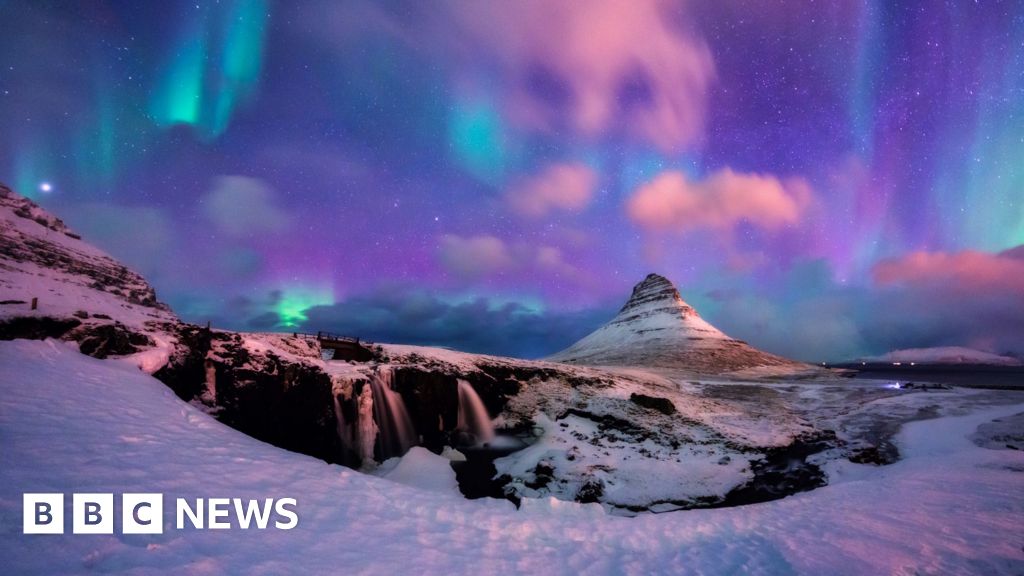
 Met Office
Met OfficeA huge solar flare, the largest since 2017, has been spotted erupting from the Sun’s surface.
Solar flares are made up of electromagnetic radiation that travel from the Sun at the speed of light and can reach Earth in about eight minutes.
They can disrupt some radio communications and satellites but most of us are unlikely to see the those effects.
There is also a chance that northern latitudes could see the Northern Lights this weekend as two geomagnetic storms are predicted to hit Earth.
Solar flares do not cause the Northern Lights. They are caused by a phenomenon called coronal mass ejections (CMEs) that erupt from an active sun spot.
Combined with flares, they can create solar storms that interact with Earth’s magnetic field or magnetosphere.
The CMEs spew out plasma and magnetic field, and up to billions of ton of material, that can hit Earth. As our magnetosphere repels the storm, it creates the aurora.
“There is the potential for a coronal mass ejection to arrive at Earth late on Friday or early on Saturday, which could lead to visible aurora for Scotland, Northern Ireland and parts of northern England,” said Met Office Space Weather Manager Krista Hammond.
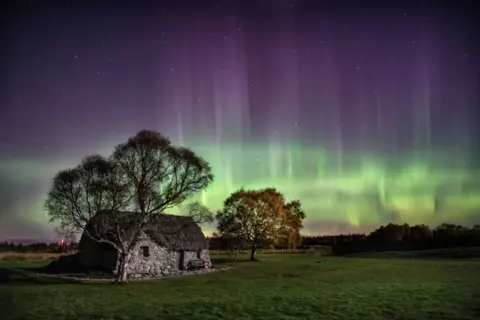 Getty Images
Getty ImagesA second CME is likely to hit Earth on Saturday and Sunday, associated with the solar flare which is rated X9.
That means “enhanced auroral visibility is possible further south across central England and similar latitudes, though cloud and rain could hamper viewing potential for some,” says Krista Hammond.
In the US, aurora might be seen in the northern states, and from the mid-west to Oregon, according to NOAA’s Space Weather Prediction Centre.
The X9 solar flare emitted is the largest categorised by Nasa. The smallest is B, followed by C, M, and X. The scale ranks from 1 to 9, so X9 is the most powerful in Nasa’s ranking.
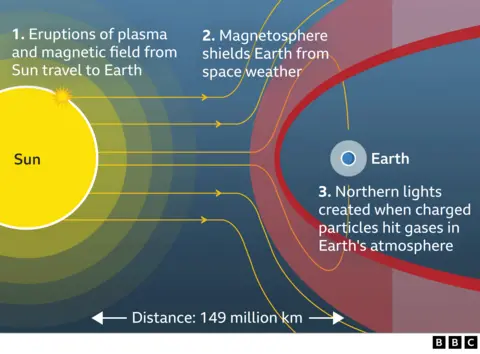
More aurora likely this year
The Sun is approaching something called “solar maximum” which is when it is most active in an 11-year cycle.
As the Sun continues in this active phase, Earth is more likely to be hit by strong geomagnetic storms, meaning there is higher chance of seeing the Aurora Borealis for the next few months.
But scientists only know if solar maximum has happened six months after the event, because they use six months of data analysing the intensity and frequency of sun spots.
Current predictions suggest we could reach solar maximum at the end of 2024 or early 2025.
What is the weather forecast in the UK
BBC weather present Simon King says the UK weather does not look good for people hoping to spot the aurora this weekend.
“It would just be the far north-east of Scotland getting the odd break in the cloud for a short time,” he says.
“If activity turns out to be a bit stronger, the best of the clear skies on Friday night will be more towards central and south England.
He says clouds may hamper viewings on Saturday night despite the evening starting with a lot of clear skies.
-

 Womens Workouts2 weeks ago
Womens Workouts2 weeks ago3 Day Full Body Women’s Dumbbell Only Workout
-

 Science & Environment3 weeks ago
Science & Environment3 weeks agoHow to unsnarl a tangle of threads, according to physics
-

 Science & Environment3 weeks ago
Science & Environment3 weeks agoHyperelastic gel is one of the stretchiest materials known to science
-

 Science & Environment3 weeks ago
Science & Environment3 weeks agoMaxwell’s demon charges quantum batteries inside of a quantum computer
-

 Technology3 weeks ago
Technology3 weeks agoWould-be reality TV contestants ‘not looking real’
-

 Science & Environment3 weeks ago
Science & Environment3 weeks ago‘Running of the bulls’ festival crowds move like charged particles
-

 Science & Environment3 weeks ago
Science & Environment3 weeks agoHow to wrap your mind around the real multiverse
-

 News2 weeks ago
News2 weeks agoOur millionaire neighbour blocks us from using public footpath & screams at us in street.. it’s like living in a WARZONE – WordupNews
-

 Science & Environment3 weeks ago
Science & Environment3 weeks agoSunlight-trapping device can generate temperatures over 1000°C
-

 Science & Environment3 weeks ago
Science & Environment3 weeks agoQuantum ‘supersolid’ matter stirred using magnets
-

 Science & Environment3 weeks ago
Science & Environment3 weeks agoITER: Is the world’s biggest fusion experiment dead after new delay to 2035?
-

 Science & Environment3 weeks ago
Science & Environment3 weeks agoLiquid crystals could improve quantum communication devices
-

 Science & Environment3 weeks ago
Science & Environment3 weeks agoQuantum forces used to automatically assemble tiny device
-
News3 weeks ago
the pick of new debut fiction
-

 Science & Environment3 weeks ago
Science & Environment3 weeks agoPhysicists are grappling with their own reproducibility crisis
-

 Science & Environment3 weeks ago
Science & Environment3 weeks agoWhy this is a golden age for life to thrive across the universe
-

 News3 weeks ago
News3 weeks agoYou’re a Hypocrite, And So Am I
-

 Sport3 weeks ago
Sport3 weeks agoJoshua vs Dubois: Chris Eubank Jr says ‘AJ’ could beat Tyson Fury and any other heavyweight in the world
-

 Science & Environment3 weeks ago
Science & Environment3 weeks agoTime travel sci-fi novel is a rip-roaringly good thought experiment
-

 Science & Environment3 weeks ago
Science & Environment3 weeks agoLaser helps turn an electron into a coil of mass and charge
-

 Science & Environment3 weeks ago
Science & Environment3 weeks agoCaroline Ellison aims to duck prison sentence for role in FTX collapse
-

 Science & Environment3 weeks ago
Science & Environment3 weeks agoNuclear fusion experiment overcomes two key operating hurdles
-

 Technology1 week ago
Technology1 week ago‘From a toaster to a server’: UK startup promises 5x ‘speed up without changing a line of code’ as it plans to take on Nvidia, AMD in the generative AI battlefield
-

 Football1 week ago
Football1 week agoFootball Focus: Martin Keown on Liverpool’s Alisson Becker
-
Business1 week ago
Eurosceptic Andrej Babiš eyes return to power in Czech Republic
-

 Science & Environment3 weeks ago
Science & Environment3 weeks agoRethinking space and time could let us do away with dark matter
-

 MMA1 week ago
MMA1 week agoConor McGregor challenges ‘woeful’ Belal Muhammad, tells Ilia Topuria it’s ‘on sight’
-

 Science & Environment3 weeks ago
Science & Environment3 weeks agoNerve fibres in the brain could generate quantum entanglement
-

 News3 weeks ago
News3 weeks ago▶️ Hamas in the West Bank: Rising Support and Deadly Attacks You Might Not Know About
-
Business1 week ago
Should London’s tax exiles head for Spain, Italy . . . or Wales?
-

 News3 weeks ago
News3 weeks ago▶️ Media Bias: How They Spin Attack on Hezbollah and Ignore the Reality
-

 Science & Environment3 weeks ago
Science & Environment3 weeks agoFuture of fusion: How the UK’s JET reactor paved the way for ITER
-

 Science & Environment2 weeks ago
Science & Environment2 weeks agoX-rays reveal half-billion-year-old insect ancestor
-

 News3 weeks ago
News3 weeks agoIsrael strikes Lebanese targets as Hizbollah chief warns of ‘red lines’ crossed
-

 Science & Environment3 weeks ago
Science & Environment3 weeks agoA new kind of experiment at the Large Hadron Collider could unravel quantum reality
-

 Science & Environment3 weeks ago
Science & Environment3 weeks agoA slight curve helps rocks make the biggest splash
-

 News3 weeks ago
News3 weeks agoNew investigation ordered into ‘doorstep murder’ of Alistair Wilson
-

 Science & Environment3 weeks ago
Science & Environment3 weeks agoUK spurns European invitation to join ITER nuclear fusion project
-

 CryptoCurrency3 weeks ago
CryptoCurrency3 weeks agoCardano founder to meet Argentina president Javier Milei
-

 News2 weeks ago
News2 weeks agoWhy Is Everyone Excited About These Smart Insoles?
-

 Science & Environment2 weeks ago
Science & Environment2 weeks agoMeet the world's first female male model | 7.30
-

 Technology2 weeks ago
Technology2 weeks agoRobo-tuna reveals how foldable fins help the speedy fish manoeuvre
-

 Technology2 weeks ago
Technology2 weeks agoGet ready for Meta Connect
-
Business3 weeks ago
JPMorgan in talks to take over Apple credit card from Goldman Sachs
-

 CryptoCurrency3 weeks ago
CryptoCurrency3 weeks agoBitcoin bulls target $64K BTC price hurdle as US stocks eye new record
-

 Womens Workouts2 weeks ago
Womens Workouts2 weeks agoBest Exercises if You Want to Build a Great Physique
-

 Womens Workouts2 weeks ago
Womens Workouts2 weeks agoEverything a Beginner Needs to Know About Squatting
-

 News2 weeks ago
News2 weeks agoFour dead & 18 injured in horror mass shooting with victims ‘caught in crossfire’ as cops hunt multiple gunmen
-

 Servers computers2 weeks ago
Servers computers2 weeks agoWhat are the benefits of Blade servers compared to rack servers?
-

 Technology1 week ago
Technology1 week agoQuantum computers may work better when they ignore causality
-

 Technology1 week ago
Technology1 week agoThe best robot vacuum cleaners of 2024
-

 Health & fitness1 week ago
Health & fitness1 week agoThe 7 lifestyle habits you can stop now for a slimmer face by next week
-

 CryptoCurrency3 weeks ago
CryptoCurrency3 weeks agoEthereum is a 'contrarian bet' into 2025, says Bitwise exec
-

 Health & fitness3 weeks ago
Health & fitness3 weeks agoThe secret to a six pack – and how to keep your washboard abs in 2022
-

 Science & Environment3 weeks ago
Science & Environment3 weeks agoQuantum time travel: The experiment to ‘send a particle into the past’
-

 Science & Environment3 weeks ago
Science & Environment3 weeks agoWhy we need to invoke philosophy to judge bizarre concepts in science
-

 CryptoCurrency3 weeks ago
CryptoCurrency3 weeks agoBitcoin miners steamrolled after electricity thefts, exchange ‘closure’ scam: Asia Express
-

 CryptoCurrency3 weeks ago
CryptoCurrency3 weeks agoDorsey’s ‘marketplace of algorithms’ could fix social media… so why hasn’t it?
-

 CryptoCurrency3 weeks ago
CryptoCurrency3 weeks agoDZ Bank partners with Boerse Stuttgart for crypto trading
-

 CryptoCurrency3 weeks ago
CryptoCurrency3 weeks agoLow users, sex predators kill Korean metaverses, 3AC sues Terra: Asia Express
-
Politics2 weeks ago
UK consumer confidence falls sharply amid fears of ‘painful’ budget | Economics
-

 Science & Environment2 weeks ago
Science & Environment2 weeks agoCNN TÜRK – 🔴 Canlı Yayın ᴴᴰ – Canlı TV izle
-

 Womens Workouts2 weeks ago
Womens Workouts2 weeks ago3 Day Full Body Toning Workout for Women
-

 Travel2 weeks ago
Travel2 weeks agoDelta signs codeshare agreement with SAS
-

 Politics2 weeks ago
Politics2 weeks agoHope, finally? Keir Starmer’s first conference in power – podcast | News
-

 News2 weeks ago
News2 weeks agoUS Newspapers Diluting Democratic Discourse with Political Bias
-

 Sport1 week ago
Sport1 week agoWatch UFC star deliver ‘one of the most brutal knockouts ever’ that left opponent laid spark out on the canvas
-

 Sport3 weeks ago
Sport3 weeks agoUFC Edmonton fight card revealed, including Brandon Moreno vs. Amir Albazi headliner
-

 Technology3 weeks ago
Technology3 weeks agoiPhone 15 Pro Max Camera Review: Depth and Reach
-

 Science & Environment3 weeks ago
Science & Environment3 weeks agoHow one theory ties together everything we know about the universe
-

 News3 weeks ago
News3 weeks agoBrian Tyree Henry on voicing young Megatron, his love for villain roles
-

 Health & fitness3 weeks ago
Health & fitness3 weeks agoThe maps that could hold the secret to curing cancer
-

 Science & Environment3 weeks ago
Science & Environment3 weeks agoBeing in two places at once could make a quantum battery charge faster
-

 Science & Environment3 weeks ago
Science & Environment3 weeks agoTiny magnet could help measure gravity on the quantum scale
-

 Science & Environment3 weeks ago
Science & Environment3 weeks agoA tale of two mysteries: ghostly neutrinos and the proton decay puzzle
-

 Science & Environment3 weeks ago
Science & Environment3 weeks agoHow do you recycle a nuclear fusion reactor? We’re about to find out
-

 CryptoCurrency3 weeks ago
CryptoCurrency3 weeks agoRedStone integrates first oracle price feeds on TON blockchain
-

 CryptoCurrency3 weeks ago
CryptoCurrency3 weeks agoBlockdaemon mulls 2026 IPO: Report
-
Politics3 weeks ago
‘Appalling’ rows over Sue Gray must stop, senior ministers say | Sue Gray
-

 CryptoCurrency3 weeks ago
CryptoCurrency3 weeks agoCoinbase’s cbBTC surges to third-largest wrapped BTC token in just one week
-

 MMA2 weeks ago
MMA2 weeks agoRankings Show: Is Umar Nurmagomedov a lock to become UFC champion?
-

 TV2 weeks ago
TV2 weeks agoCNN TÜRK – 🔴 Canlı Yayın ᴴᴰ – Canlı TV izle
-

 Technology3 weeks ago
Technology3 weeks agoThe ‘superfood’ taking over fields in northern India
-

 CryptoCurrency3 weeks ago
CryptoCurrency3 weeks agoCrypto scammers orchestrate massive hack on X but barely made $8K
-

 CryptoCurrency3 weeks ago
CryptoCurrency3 weeks agoDecentraland X account hacked, phishing scam targets MANA airdrop
-

 CryptoCurrency3 weeks ago
CryptoCurrency3 weeks agoTelegram bot Banana Gun’s users drained of over $1.9M
-

 CryptoCurrency3 weeks ago
CryptoCurrency3 weeks agoVonMises bought 60 CryptoPunks in a month before the price spiked: NFT Collector
-

 CryptoCurrency3 weeks ago
CryptoCurrency3 weeks agoSEC asks court for four months to produce documents for Coinbase
-

 CryptoCurrency3 weeks ago
CryptoCurrency3 weeks ago‘Silly’ to shade Ethereum, the ‘Microsoft of blockchains’ — Bitwise exec
-

 CryptoCurrency3 weeks ago
CryptoCurrency3 weeks agoVitalik tells Ethereum L2s ‘Stage 1 or GTFO’ — Who makes the cut?
-

 CryptoCurrency3 weeks ago
CryptoCurrency3 weeks ago‘No matter how bad it gets, there’s a lot going on with NFTs’: 24 Hours of Art, NFT Creator
-
Business3 weeks ago
Thames Water seeks extension on debt terms to avoid renationalisation
-
Business3 weeks ago
How Labour donor’s largesse tarnished government’s squeaky clean image
-

 News3 weeks ago
News3 weeks agoBrian Tyree Henry on voicing young Megatron, his love for villain roles
-
News2 weeks ago
The Project Censored Newsletter – May 2024
-

 Womens Workouts2 weeks ago
Womens Workouts2 weeks agoHow Heat Affects Your Body During Exercise
-

 Womens Workouts2 weeks ago
Womens Workouts2 weeks agoKeep Your Goals on Track This Season
-

 Womens Workouts2 weeks ago
Womens Workouts2 weeks agoWhich Squat Load Position is Right For You?
-

 MMA1 week ago
MMA1 week agoRoberto Satoshi compares losses to Francis Ngannou’s boxing run as he finally defends RIZIN title
-
Business6 days ago
Ukraine faces its darkest hour



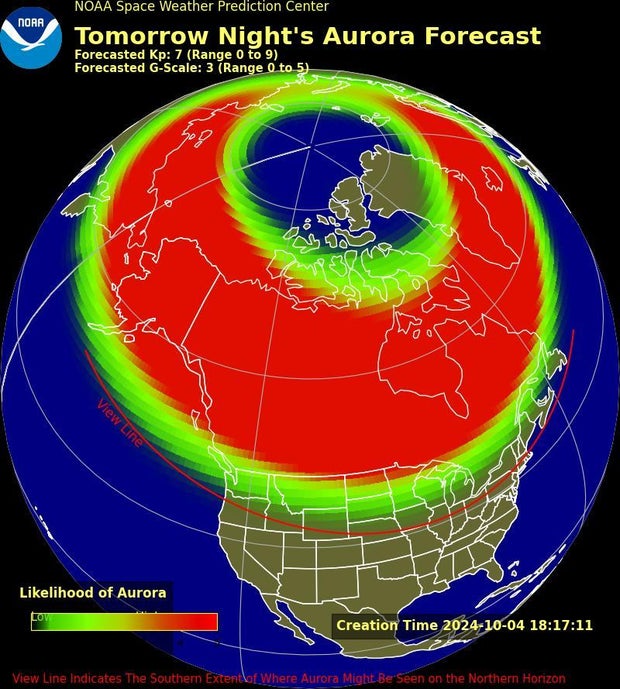
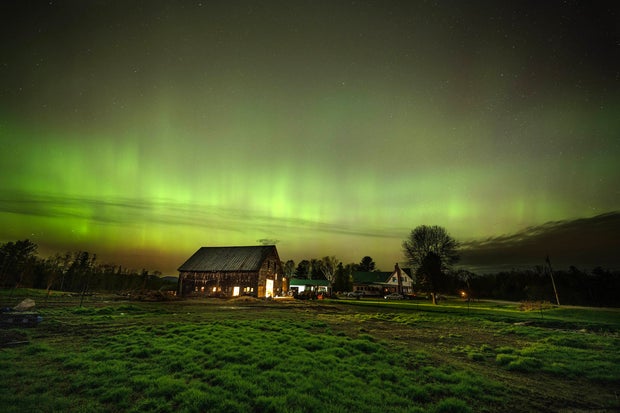
You must be logged in to post a comment Login